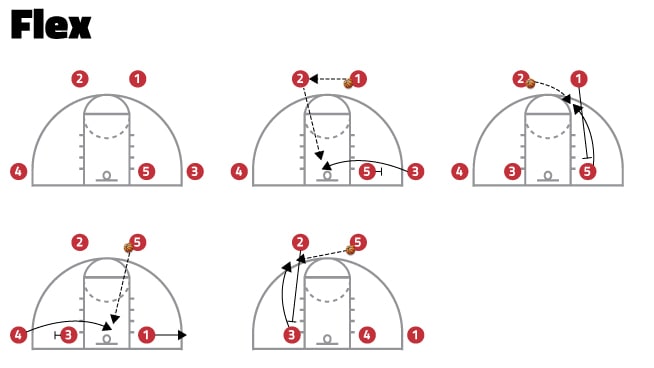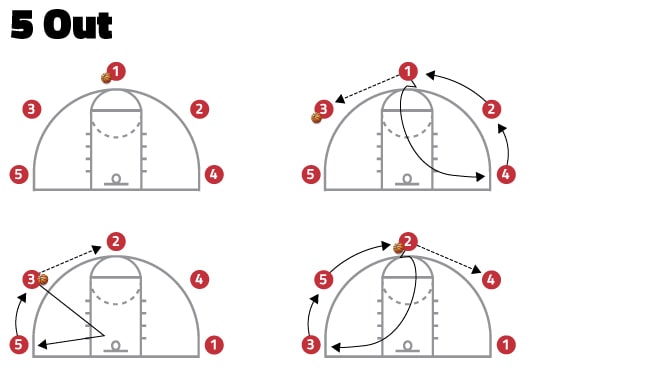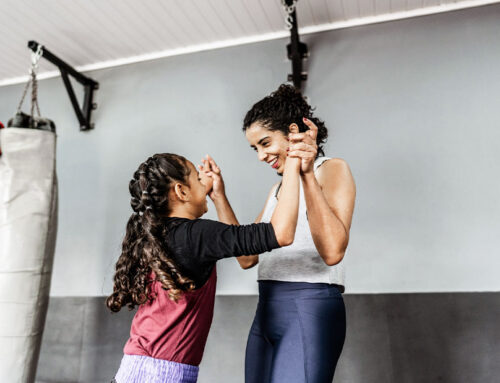Basic Offensive Plays for Youth Basketball Coaches
In youth basketball, most productive offensive plays are characterized by continuous passing and simple movement. Motion or continuity offenses will contain passes, cuts and screens in either a free flowing system that enables your players to make reads and decisions, within some basic rules or in a fixed pattern that will lead back to the starting formation to be repeated.
Motion offenses are great for youth basketball because they allow every player to handle the ball, make decisions and have scoring opportunities that will help their development.
They also won’t confine players to specific positions based on their size, so young players will have a chance to work on many different skills and gain experiences at different spots throughout a game.
There are motion-based offenses that can be run against both man-to-man and zone defenses, and these basic sets can be effective for your youth team.
Offense vs. Man-to-Man Defense

Basic Motion
- Basic Motion begins with the ball handler in the middle of the court, beyond the 3-point line, or “up top.” There is one player on each wing and one player on each block.
- Players 4 and 5 on the wings will set down screens on the defenders guarding Players 2 and 3 on the block. Players 2 and 3 will run off the screens to the wing, ready to receive a pass from Player 1, the current ball handler, who can throw it to either wing.
Note: At the youth level these numbers (e.g., “Player 4”) should not necessarily designate a position, because in a motion offense all players will get to play all positions Restricting a youth player to a specific position can hinder their development.
- On the pass from the 1 to the 3, both the 1 and the 5 will screen away. The 1 will run to the opposite wing to set a screen for the 2, and the 5 will run to the opposite block to set a screen for the 4. The 2 will use the screen to curl for a layup or jump shot at the free-throw line and will cut to the top spot should they not be open. The 5 will flash across the paint for an open layup or post feed.
- With the ball, the 3 will look to pass to the 2 or the 5 for a shot, but if neither are open initially, the 3 will swing the ball to the 2 who has now cut up top.
- The 2 will hold the ball up top as the 1 and the 3 set down screens for the 4 and the 5, and play begins to repeat itself.
Flex
- Flex begins with two players up top, who are opposite each other beyond the 3-point line, one player in each of the two baseline corners and one player on the block.
- The action will begin with a pass from the 1 to the 2. As the pass is made, the 5 will step toward the 3 and set a “flex screen” along the baseline. The 3 will make a “flex cut” off the 5’s screen and into the paint for a open layup or post feed.
- After the 5 has set his screen and the flex cut has been made, the 1 will set a down screen for the 5. The 5 will use this screen to run toward the elbow/free-throw line area or the 3-point line for an open jump shot.
- The 2 who currently possesses the ball will look to pass to the 3 or the 5 for a shot, but should neither of those shots be open, the 5 will cut up top to receive the pass from the 2 and continue the offense.
- Once the ball has been swung to the 5, the 3 who has made his cut and remained on the block will step out to screen for the 4 who is still in the corner. The 4 will make a flex cut off the screen, then the 2 will down screen for the 3, and the flex offense resets to repeat itself.

5 Out
5 Out begins with the ball handler up top, one player on each wing and one player in each of the baseline corners.
- This is a free flowing offense with no specific pattern of passes, cuts or screens to be made but the offense follows a few rules.
- “Pass and Cut.” Once you make a pass to a teammate on the perimeter you will make a cut toward the basket.
- If you do not receive a pass for a shot on your cut, you will fill to the corner in the opposite direction of the pass you made. So for example if you passed to the right wing you will cut and then fill to the left corner.
- Once a cut has been made, the players who are on the side opposite the direction of the pass will fill the open spots in the formation.
- On the pass from the 1 to the 3, the 1 will cut to the basket and fill the left corner. Then the 2 will fill the top spot and the 4 will fill the wing spot.
- If the 3 decides to pass to the 2 up top, the 3 will then cut to the basket and fill away from the direction of the pass to the right corner.
- 5 Out can be run continuously with passes, cuts and opposite fills until a play is made and a shot is created.
-
- Variation: “Pass and Screen Away”
- This rule will mean that once a player makes a pass, they will turn and set a screen for their first teammate in the opposite direction and then fill that corner. The teammate will use this screen to curl for an open shot or then fill the corner of the side from which they came. Players then will fill the open spots and this play can also be ran continuously.
- Variation: “Pass and Screen Away”
4 Out
- 4 Out begins with two players up top, one player in each corner and one player on the block.
- 4 Out will follow the same free flowing “pass and cut” or “pass and screen away” rules as 5 Out. However, the 5 will move from block to block to keep the floor spaced and also make themselves available for post feeds instead of playing on the perimeter.
Offense vs. Zone Defense
High-Low
- High-Low begins with the ball handler up top, one player on each wing, one player on the free-throw line, and one player on the block. This set should be used against zone defenses that have a two-man front such as a 2-3 or 2-1-2. Having one player up top and one player on each wing will allow your team to swing the ball and attack gaps.
- The High-Low zone offense relies on quick swing passes and long skip passes around the perimeter and entries into the two middle players. The goal is to pass the ball and get the defense moving and then attack gaps from the perimeter or enter the ball into the middle of the zone where the defense is weakest. Then the offense relies on the players to freely make plays for themselves or teammates.
- The basic pattern for high low is that as the ball is swung around the perimeter the two players inside will yo-yo from high (the free-throw line area) to low (the block or short corner area). On the perimeter, if the ball is on the wing the player up top and the player on the opposite wing can interchange to create different looks and keep the defense occupied.
- As the ball is passed from the 1 to the 3, the 4 will drop down to the right block and post up, making themselves available for a post feed. The 5 will then fill to the free-throw line area and find space to make themselves open to receive a pass and make a play.
- Once the ball is swung or skipped to the 2 on the opposite wing, the 5 will then drop down to the block, and the 4 will fill back up to the free-throw line area. Here is also where the 1 and 3 can switch spots.
- This action should continue until a perimeter player has an open 3-point shot, has the opportunity to dribble penetrate through the zone and score or find an open teammate, or pass to one of the two players inside who can then also make a play.
4 Corners
- 4 Corners begins with two players up top (spread further apart), one player in each baseline corner, and one player who will usually start around the free-throw line but can also start on either block. This set should be used against zone defenses that have one-man or three-man fronts such as a 3-2 or 1-3-1. Having two players up top and two players in the corner will allow your team to exploit the gaps in these zones.
- The 4 Corners offense relies on the same zone offense principles of “High-Low” as far as passing and attacking gaps.
- As the ball is swung around the 4 perimeter players, the one player inside will rotate around the middle from the blocks to the free-throw area looking to find space and make themselves available. The two perimeter players who share the same side of the court can interchange when the ball is on the opposite side.
- On the pass from the 1 to the 3, the 5 will drop down to the block area looking to post up.
- As the ball is rotated back around to the 2, the 5 will cut up to the free-throw line area and try to get open.
- Finally as the ball is passed to the 4 in the corner the 5 will drop down to the opposite block area.
READ MORE:
RECOMMENDED FOR YOU
MOST POPULAR
Basic Offensive Plays for Youth Basketball Coaches
In youth basketball, most productive offensive plays are characterized by continuous passing and simple movement. Motion or continuity offenses will contain passes, cuts and screens in either a free flowing system that enables your players to make reads and decisions, within some basic rules or in a fixed pattern that will lead back to the starting formation to be repeated.
Motion offenses are great for youth basketball because they allow every player to handle the ball, make decisions and have scoring opportunities that will help their development.
They also won’t confine players to specific positions based on their size, so young players will have a chance to work on many different skills and gain experiences at different spots throughout a game.
There are motion-based offenses that can be run against both man-to-man and zone defenses, and these basic sets can be effective for your youth team.
Offense vs. Man-to-Man Defense

Basic Motion
- Basic Motion begins with the ball handler in the middle of the court, beyond the 3-point line, or “up top.” There is one player on each wing and one player on each block.
- Players 4 and 5 on the wings will set down screens on the defenders guarding Players 2 and 3 on the block. Players 2 and 3 will run off the screens to the wing, ready to receive a pass from Player 1, the current ball handler, who can throw it to either wing.
Note: At the youth level these numbers (e.g., “Player 4”) should not necessarily designate a position, because in a motion offense all players will get to play all positions Restricting a youth player to a specific position can hinder their development.
- On the pass from the 1 to the 3, both the 1 and the 5 will screen away. The 1 will run to the opposite wing to set a screen for the 2, and the 5 will run to the opposite block to set a screen for the 4. The 2 will use the screen to curl for a layup or jump shot at the free-throw line and will cut to the top spot should they not be open. The 5 will flash across the paint for an open layup or post feed.
- With the ball, the 3 will look to pass to the 2 or the 5 for a shot, but if neither are open initially, the 3 will swing the ball to the 2 who has now cut up top.
- The 2 will hold the ball up top as the 1 and the 3 set down screens for the 4 and the 5, and play begins to repeat itself.
Flex
- Flex begins with two players up top, who are opposite each other beyond the 3-point line, one player in each of the two baseline corners and one player on the block.
- The action will begin with a pass from the 1 to the 2. As the pass is made, the 5 will step toward the 3 and set a “flex screen” along the baseline. The 3 will make a “flex cut” off the 5’s screen and into the paint for a open layup or post feed.
- After the 5 has set his screen and the flex cut has been made, the 1 will set a down screen for the 5. The 5 will use this screen to run toward the elbow/free-throw line area or the 3-point line for an open jump shot.
- The 2 who currently possesses the ball will look to pass to the 3 or the 5 for a shot, but should neither of those shots be open, the 5 will cut up top to receive the pass from the 2 and continue the offense.
- Once the ball has been swung to the 5, the 3 who has made his cut and remained on the block will step out to screen for the 4 who is still in the corner. The 4 will make a flex cut off the screen, then the 2 will down screen for the 3, and the flex offense resets to repeat itself.

5 Out
5 Out begins with the ball handler up top, one player on each wing and one player in each of the baseline corners.
- This is a free flowing offense with no specific pattern of passes, cuts or screens to be made but the offense follows a few rules.
- “Pass and Cut.” Once you make a pass to a teammate on the perimeter you will make a cut toward the basket.
- If you do not receive a pass for a shot on your cut, you will fill to the corner in the opposite direction of the pass you made. So for example if you passed to the right wing you will cut and then fill to the left corner.
- Once a cut has been made, the players who are on the side opposite the direction of the pass will fill the open spots in the formation.
- On the pass from the 1 to the 3, the 1 will cut to the basket and fill the left corner. Then the 2 will fill the top spot and the 4 will fill the wing spot.
- If the 3 decides to pass to the 2 up top, the 3 will then cut to the basket and fill away from the direction of the pass to the right corner.
- 5 Out can be run continuously with passes, cuts and opposite fills until a play is made and a shot is created.
-
- Variation: “Pass and Screen Away”
- This rule will mean that once a player makes a pass, they will turn and set a screen for their first teammate in the opposite direction and then fill that corner. The teammate will use this screen to curl for an open shot or then fill the corner of the side from which they came. Players then will fill the open spots and this play can also be ran continuously.
- Variation: “Pass and Screen Away”
4 Out
- 4 Out begins with two players up top, one player in each corner and one player on the block.
- 4 Out will follow the same free flowing “pass and cut” or “pass and screen away” rules as 5 Out. However, the 5 will move from block to block to keep the floor spaced and also make themselves available for post feeds instead of playing on the perimeter.
Offense vs. Zone Defense
High-Low
- High-Low begins with the ball handler up top, one player on each wing, one player on the free-throw line, and one player on the block. This set should be used against zone defenses that have a two-man front such as a 2-3 or 2-1-2. Having one player up top and one player on each wing will allow your team to swing the ball and attack gaps.
- The High-Low zone offense relies on quick swing passes and long skip passes around the perimeter and entries into the two middle players. The goal is to pass the ball and get the defense moving and then attack gaps from the perimeter or enter the ball into the middle of the zone where the defense is weakest. Then the offense relies on the players to freely make plays for themselves or teammates.
- The basic pattern for high low is that as the ball is swung around the perimeter the two players inside will yo-yo from high (the free-throw line area) to low (the block or short corner area). On the perimeter, if the ball is on the wing the player up top and the player on the opposite wing can interchange to create different looks and keep the defense occupied.
- As the ball is passed from the 1 to the 3, the 4 will drop down to the right block and post up, making themselves available for a post feed. The 5 will then fill to the free-throw line area and find space to make themselves open to receive a pass and make a play.
- Once the ball is swung or skipped to the 2 on the opposite wing, the 5 will then drop down to the block, and the 4 will fill back up to the free-throw line area. Here is also where the 1 and 3 can switch spots.
- This action should continue until a perimeter player has an open 3-point shot, has the opportunity to dribble penetrate through the zone and score or find an open teammate, or pass to one of the two players inside who can then also make a play.
4 Corners
- 4 Corners begins with two players up top (spread further apart), one player in each baseline corner, and one player who will usually start around the free-throw line but can also start on either block. This set should be used against zone defenses that have one-man or three-man fronts such as a 3-2 or 1-3-1. Having two players up top and two players in the corner will allow your team to exploit the gaps in these zones.
- The 4 Corners offense relies on the same zone offense principles of “High-Low” as far as passing and attacking gaps.
- As the ball is swung around the 4 perimeter players, the one player inside will rotate around the middle from the blocks to the free-throw area looking to find space and make themselves available. The two perimeter players who share the same side of the court can interchange when the ball is on the opposite side.
- On the pass from the 1 to the 3, the 5 will drop down to the block area looking to post up.
- As the ball is rotated back around to the 2, the 5 will cut up to the free-throw line area and try to get open.
- Finally as the ball is passed to the 4 in the corner the 5 will drop down to the opposite block area.
READ MORE:










